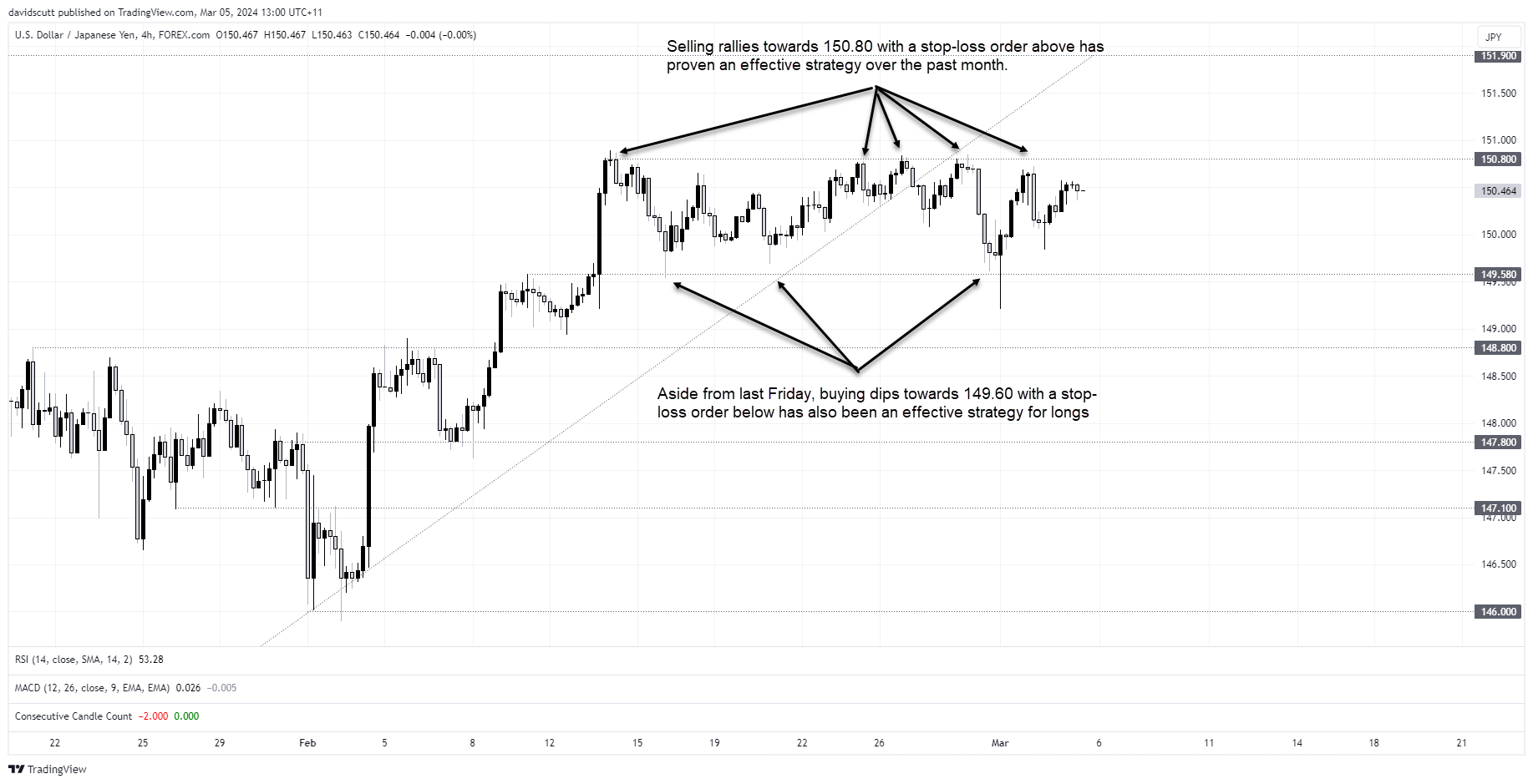
- Underlying inflationary pressures in Tokyo intensified in February
- The BOJ remains likely to abandon negative interest rates, although the move looks like it may occur in April
- The US interest rate outlook should be the focus of USD/JPY traders, not the BOJ
- Range trade is favoured near-term with sizeable longer-term downside risks
Underlying disinflationary pressures in Tokyo intensified last month, pointing to the likelihood of similar trends nationally and underscoring the need for wage growth to reach sufficient levels to boost flagging consumer demand.
For the moment, USD/JPY continues to provide tailwinds for the Japanese economy, remains supported above 150 on historically wide interest rate differentials with the rest of the world.
Tokyo underlying price pressures ease
Ahead of the national release in late March, the advanced Tokyo consumer price inflation (CPI) report revealed core-core inflation – which removes the impact of volatile fresh food and energy prices – rose 3.1% in year to February, down from 3.3% in January and the slowest pace since February 2023.
Importantly, however, while it continues to decelerate from the 4% plus levels seen late last year, this key measure of underlying inflation remains above the BOJ’s 2% target, keeping the prospect of a rate hike alive either this month or next.
BOJ still looks like it wants to hike rates
The BOJ next meets to discuss interest rates March 18 and 19. Whether it pulls the trigger and lift its overnight rate from -0.1% will largely come down whether it has confidence that tight labour market conditions and prior elevated inflation will be enough to foster strong wage growth, helping to underpin consumer spending and eradicate the disinflationary mindset that Japan has been grappling with for decades.
While poor demographics and heavy levels of household and government indebtedness are serious roadblocks to achieving that goal longer-term, in the short-term, it looks like the BOJ wants to hike as longs annual wage negotiations deliver sufficient wage pressures to begin the process. The negotiations are underway and will be announced before the end of March. Early signs suggest the BOJ will get its wish.
Markets are on board for the BOJ to proceed with one-year OIS – which measures where markets see the overnight borrowing rates sitting in a year’s time – pricing in 23 basis points worth of hikes over that period. Macroeconomic conditions globally are also about as good as it gets for the BOJ, allowing it to begin normalising policy without causing major ructions to financial markets.
It just needs to get on with the process.

Source: Refinitiv
BOJ April hike appears more likely
While some on the BOJ board appear keen to move as soon this month, Governor Kazuo Ueda appeared more cautious when he spoke late last week, suggesting that when negative rates are abandoned, it will likely be in April after wage negotiations have concluded.
But it’s the Fed USD/JPY traders should focus on
Regardless of what Japanese policymakers choose to do, as outlined in post last week, for USD/JPY traders it’s really about what the Fed signals regarding the rate outlook that you really need to worry about. While the BOJ can generate intraday volatility, it’s the Fed that’s dictating the longer-term trend.
Looking at USD/JPY right now, the most effective strategy is to simply play the range, buying dips around 149.60 and selling pops towards 150.80, allowing for stops to be put on the opposite side for protection against a potential break. Outside last Friday when a soft US manufacturing PMI sparked a big drop in US bond yields, the strategy has been solid for nearly a month.
While the price sits closer to resistance at 150.80 right now, making a short stack up better on a risk-reward basis, I’d be reluctant to enter a position ahead of the ISM non-manufacturing PMI report later Tuesday given it can be volatile month-to-month and everyone will be watching it.
Respect the range until the price doesn’t.

While I see plenty of downside in the future, just like the BOJ when it comes to considering when to begin to lift interest rates, you need to have patience. When the Fed signals it’s about to start easing rates, that could be the moment the trapdoor eventually opens towards lower levels.
-- Written by David Scutt
Follow David on Twitter @scutty
How to trade with City Index
You can trade with City Index by following these four easy steps:
-
Open an account, or log in if you’re already a customer
• Open an account in the UK
• Open an account in Australia
• Open an account in Singapore
- Search for the market you want to trade in our award-winning platform
- Choose your position and size, and your stop and limit levels
- Place the trade










